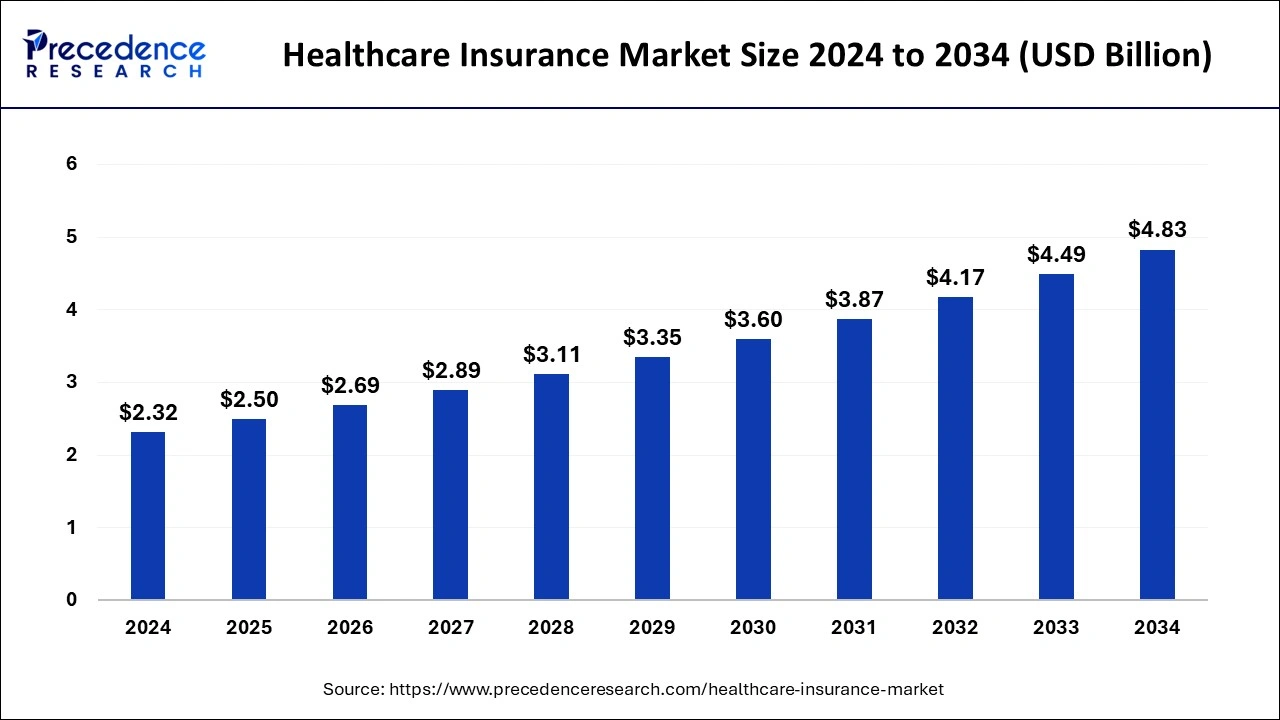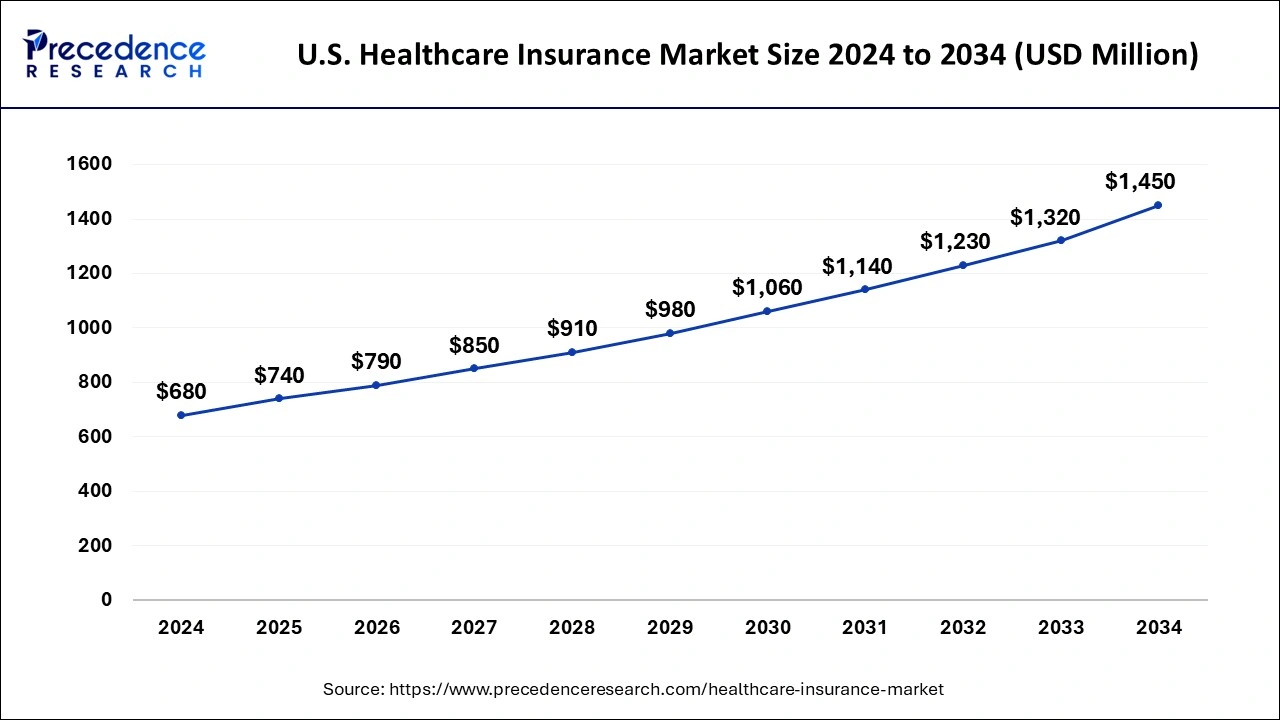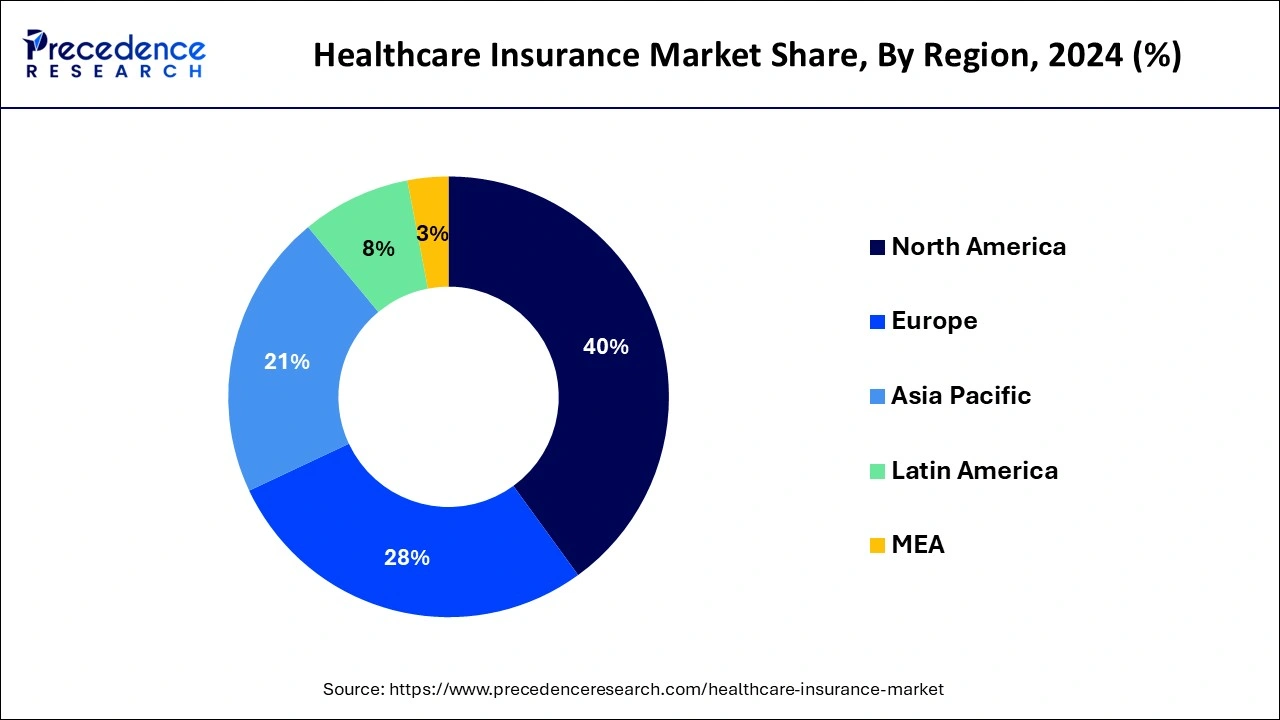List of Contents
What is the Healthcare Insurance Market Size?
The global healthcare insurance market size is calculated at USD 2.50 billion in 2025 and is predicted to increase from USD 2.69 billion in 2026 to approximately USD 4.83 billion by 2034, expanding at a CAGR of 7.60% from 2025 to 2034.. The key players operating in the market are focused on adopting inorganic growth strategies like acquisition and merger to develop healthcare insurances which is estimated to drive the global healthcare insuarance market over the forecast period.

Market Highlights
- North America dominated the healthcare insurance market in 2024.
- Asia Pacific is expected to grow at a significant rate in the market during the forecast period.
- By provider, the cerebral embolization and aneurysm coiling devices segment dominated the market with the largest share in 2024.
- By coverage type, stroke segment is expected to grow at significant rate during the forecast period.
- By network provider, the 0.021" segment dominated the market with the largest share in 2024.
- By plan type, the cerebral embolization and aneurysm coiling devices segment dominated the market with the largest share in 2024.
- By age group, stroke segment is expected to grow at significant rate during the forecast period.
- By distribution channel, the hospitals segment dominated the healthcare insurance market in 2024.
Market Size and Forecast
- Market Size in 2025: USD 2.50 Billion
- Market Size in 2026: USD 2.69 Billion
- Forecasted Market Size by 2034: USD 4.83 Billion
- CAGR (2025-2034): 7.60%
- Largest Market in 2024: North America
- Fastest Growing Market: Asia Pacific
How Can AI Improve the Healthcare Insurance Industry?
Artificial intelligence integration has the potential to transform the healthcare insurance industry by improving customer experiences, enhancing efficiency, and reducing costs. AI can analyze historical data to assess risk more accurately and customize premiums for individuals or groups. AI integration helps to improve risk assessment and underwriting. Machine learning models evaluate health records, lifestyle habits, and genetic data to predict potential health issues.
AI can identify patterns of fraudulent claims using anomaly detection algorithms. AI-driven systems can process claims faster by validating documents and determining eligibility without manual intervention. AI minimizes human errors in claims processing, improving accuracy and customer satisfaction.
Healthcare Insurance Market Growth Factors
- Increasing numbers of elderly people lead to higher healthcare needs and insurance demands, has estimated to drive the growth of the healthcare insurance market in near future.
- Expanding populations, particularly in developing regions, contribute to market growth.
- Higher income levels enable more people to afford health insurance, which has estimated to drive the growth of the healthcare insurance market in near future.
- Increased understanding of healthcare risks and benefits of insurance drives market growth.
- As people migrate to urban areas, access to healthcare facilities improves, increasing insurance uptake.
- Increasing regulatory support is estimated to drive the growth of the market over the forecast period.
Market Scope
| Report Highlights | Details |
| Market Size in 2025 | USD 2.50 Billion |
| Market Size in 2026 | USD 2.69 Billion |
| Market Size by 2034 | USD 4.83 Billion |
| Growth Rate from 2025 to 2034 | CAGR of 7.60% |
| Largest Market | North America |
| Base Year | 2024 |
| Forecast Period | 2025 to 2034 |
| Segments Covered | Provider, Coverage Type, Network Provider, Plan Type, Level of Coverage, Age Group, Distribution Channel, and Regions |
| Regions Covered | North America, Europe, Asia-Pacific, Latin America, and Middle East & Africa |
Market Dynamics
Drivers
Employment Growth & Growing Government Subsidies
Employer-sponsored health insurance plans increase with rising employment levels. Subsidized health insurance plans make coverage accessible to lower-income groups. Subsidies reduce the financial burden of purchasing health insurance, making it affordable for low- and middle-income individuals. This increases enrollment in health insurance plans, expanding the customer base for insurers. Subsidized health insurance programs often include incentives, such as tax benefits or premium discounts, encouraging more people to opt in. Governments may fund programs for specific groups, like children, the elderly, or low-income families, directly increasing coverage rates. Subsidies enable collaboration between governments and private insurers, where private companies administer subsidized plans, growing their market share. Subsidies can make advanced insurance plans affordable, increasing demand for policies with broader coverage and value-added services.
- For instance, in November 2024, Ayushman Bharat, the Central Government's premier senior healthcare insurance program, is scheduled to make its official debut in Kerala this month. The fact that more than 4 lakh people in the state have already signed up for the program is a sign of its broad appeal. Under the Pradhan Mantri Jan Arogya Yojana (PMJAY) paradigm, the Ayushman Bharat initiative seeks to offer health insurance to senior individuals, guaranteeing financial security for hospital stays in secondary and tertiary care. The program intends to provide healthcare coverage to a large number of senior folks by making critical medical treatments more easily accessible to them through its debut in Kerala.
Segments Insights
Provider Insights
The public segment accounted 56% revenue share in 2024 and is estimated to sustain its dominance during the forecast period. This is attributed to the increased public confidence and trust because the government itself acts as the main insurer and the provider of the services relating to healthcare. For instance, LIC Corporation in India and Medicare of the Federal government in US. Furthermore, public health insurance companies offers safety and operates at low cost.
The private segment is estimated to be the most opportunistic segment during the forecast period. The private players are coming up with improved healthcare services and premium options for the customers. Moreover, certain inefficiencies associated with the public sector healthcare insurance companies are overcome by the private market players, and hence is gaining more attention in the market. Moreover, they offer higher benefits as compared to that of the public segment.
Coverage Type Insights
The life-time coverage segment accounted for more than 52% of the market share. People chooses a life insurance policy as an investment option that also has huge tax-saving benefits. Moreover, the availability of wider variations of life insurance policies offered by the various market players serves the wider range of customers with different needs.
Theterm insurance segment is expected to show highest CAGR during the forecast period. This is attributed to the availability of huge benefits at low cost to the customers. It includes healthcare insurance plans that mainly covers the treatment costs at healthcare units. Therefore, rising prevalence of various chronic disease is the major driver of this segment. This also provides safety and helps the customers to safeguard their medical expenses.
Level of coverage Insights
The silver segment held a dominant presence in the healthcare insurance market in 2024. In the federal marketplace and state exchanges, silver plans are the most popular, with 70.0% of stock buyers selecting them. Those with one or two minor medical issues who need some medicine are typically the ones who use them.
The gold plans segment is expected to grow at the fastest rate in the market during the forecast period of 2025 to 2034. This could be explained by the rising incidence of chronic illnesses, which necessitate frequent medical visits and costly prescription drugs that are unaffordable out of pocket.
Age Group Insights
The adult segment registered its dominance over the global healthcare insurance market in 2024. The adult population has a significant prevalence of lifestyle diseases that can raise future health risks. Heart disease and other conditions that necessitate hospitalization are more common in the population.
- Additionally, in 2023, about 59.0% of Americans carried life insurance, which accelerated market expansion.
The senior citizen segment is expected to grow at the fastest rate in the market during the forecast period of 2025 to 2034. People over 65 are included because they are more prone to chronic illnesses, which raises the hospitalization rate. Senior health insurance plans are more essential, particularly when it comes to retirement. Additionally, it offers a number of benefits, including lifelong renewability, coverage of the outpatient department, and no medical screening prior to purchasing plans. It also offers the benefit of annual exams at no cost.
Regional Insights
U.S. Healthcare Insurance Market Size and Growth 2025 to 2034
The U.S. healthcare insurance market size is evaluated at USD 740 million in 2025 and is projected to be reach around USD 1,450 million by 2034, growing at a CAGR of 7.87% from 2025 to 2034.

North America dominated the healthcare insurance market, fueled by a combination of factors including employer-provided health coverage, the presence of high-quality medications, the national Medicare program, and an increasing emphasis on medical innovation. These dynamics contribute to the region's elevated demand for financial safeguards, particularly within the worst healthcare outcomes due to conditions like cardiovascular disease, diabetes, end-stage renal disease, and HIV infection.
American patients exhibit a wide range of preferences, from those seeking affordable financial protection due to high costs and insurance gaps to those desiring exclusive private healthcare insurance. Moreover, Canada is home to numerous healthcare insurance initiatives, which reinforce a strong presence in the market for affordable and easy access to insurance for patients' needs.
Asia Pacific is experiencing significant growth in the health insurance market, attributed to its remarkable healthcare spending capabilities, a vast patient base, and a burgeoning middle middle-class. Countries such as China and India are pivotal to the region's leadership in this sector. These nations serve as major healthcare hubs, producing a wide assortment of healthcare coverage, including government policies that promote health insurance, digital tools, and online platforms.
As individuals in Asia Pacific become more affluent and healthcare-conscious, their desire for high-end and financially sound insurance products grows. The sector's continued advancements in insurance techniques and processing, supported by favorable government policies, further cement the region's growing market position.
- According to IBEF, the insurance industry has received Foreign Direct Investment (FDI) amounting to nearly INR. 54,000 crore (US$ 6.5 billion) that is supported by government policies.
North America accounted for 40% of revenue share in 2024 and is estimated to sustain its dominance during the forecast period. North America is characterized by increased awareness regarding the benefits of healthcare insurance, increased disposable income, increased prevalence of diseases, growing geriatric population, increased demand for the latest surgeries and drugs, and increased expenditure on healthcare. All these factors has augmented the growth of the market in this region.

Asia Pacific is anticipated to grow at the fastest rate in the healthcare insurance market during the forecast period. The Asia Pacific region is the home to the world's largest population. The rapid urbanization and growing penetration of the insurance companies is fueling the market growth. The changing lifestyle of the consumers, unhealthy eating habits, and rising obesity are the major factors behind the growing prevalence of chronic diseases in the region. The rising disposable income, improving access to the internet, rising literacy rates, increasing investments on the development of advanced healthcare infrastructure, and rising awareness regarding the health insurances among the population are the most prominent factors that are expected to drive the growth of the Asia Pacific health insurance market in the forthcoming years. Increasing government initiatives in Asia Pacific region for people over age 70 has driven the market over forecast period.
- For instance, in October 2024, Along with other health-related projects totalling US$ 150.29 Billion, Prime Minister Narendra Modi announced the extension of health coverage to all senior citizens 70 years of age and older under the government's flagship Ayushman Bharat Pradhan Mantri Jan Arogya Yojana (PM-JAY).
Healthcare Insurance Market Companies
- Aetna Inc.
- AIA Group Limited
- Allianz
- ASSICURAZIONI GENERALI
- Aviva
- AXA
- Cigna
- Ping An Insurance (Group)
- UnitedHealth Group
- Zurich
Latest Announcements by Healthcare Industry Leaders:
- In October 2024, Pratik Gupta, Senior Executive Vice President & Head-Agency at TATA AIG company stated that the introduction of Flexi Shield, CanCare, EmpowerHeh OPD Care, and Mental Wellbeing new riders is an important milestone in company's plan to boost development in the health insurance market. We are committed to promoting growth throughout India, especially in tier 2 and tier 3 cities. Our objective is to increase access to high-quality healthcare for millions of people by expanding our network of hospitals, agents, and branches. Key rider highlights include CanCare's increased cancer coverage, OPD Care's coverage of outpatient charges, Flexi Shield's protection against medical inflation, EmpowerHer's emphasis on female-specific health issues, and Mental Wellbeing's industry-first mental health coverages.
Recent Developments
- In May 2025, Galaxy Health Insurance announced its aim to expand its distribution network by integrating different banking channels.
- In April 2024, S.A.R.A.H., a digital health promoter prototype with improved empathetic response powered by generative artificial intelligence (AI), has been launched by the World Health Organization (WHO) in advance of World Health Day, which is centered around the theme "My Health, My Right." S.A.R.A.H., a Smart Al Resource Assistant for Health, is an advancement of AI-driven health information avatars that makes use of state-of-the-art technology and new language models. It can engage consumers with various health subjects in eight different languages, around the clock, on any device.
- In March 2024, A cross-government public investigation of the growing influence of private equity and other companies on health care was jointly initiated by the Justice Department's Antitrust Division, the Federal Trade Commission (FTC), and the Department of Health and Human Services (HHS). The involvement of private equity firms and other corporate owners in health care system transactions is growing, and occasionally these transactions may result in the maximization of profits at the expense of high-quality care.
Segments Covered in the Report
By Provider
- Public
- Private
By Coverage Type
- Term Insurance
- Life-time Coverage
By Network Provider
- Point of Service
- Preferred Provider Organizations
- Exclusive Provider Organizations
- Health Maintenance Organizations
By Plan Type
- Medical Insurance
- Critical Illness Insurance
- Family Floater Health Insurance
- Others
By Level of Coverage
- Bronze
- Silver
- Gold
- Platinum
By Age Group
- Minor
- Adults
- Senior Citizen
By Distribution Channel
- Direst Sales
- Brokers/Agents
- Banks
- Others
By Region
- North America
- Europe
- Asia-Pacific
- Latin America
- Middle East & Africa
For inquiries regarding discounts, bulk purchases, or customization requests, please contact us at sales@precedenceresearch.com
Frequently Asked Questions
Ask For Sample
No cookie-cutter, only authentic analysis – take the 1st step to become a Precedence Research client